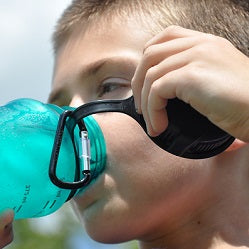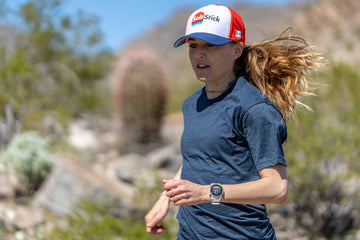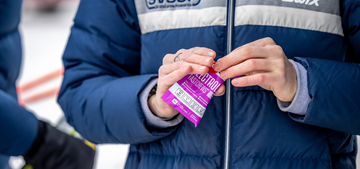
As the temperature heats up, a familiar element of summer training is returning: sweat. In this blog post, we examine the science behind sweat rates in athletes, as well as the implications to your nutrition routine.
Sweat is a well-known part of endurance sports. A winter run produces a light layer of perspiration; a summer run produces much more. It is a badge of honor because it represents hard work.
Intuitively, you may think that as an athlete you sweat less than your sedentary counterparts. It is easy to conjure an image of someone struggling to make it through a workout in the summer heat, stopping to catch his breath while dripping wet. The fitter athlete would just glide through the run without breaking much of a sweat, right?
Wrong. Your body undergoes several physiological changes
when you adapt to the heat. In addition to increases in blood plasma volume and heat tolerance, one change that happens is an increase in sweat rate.
The sweating process is your body’s attempt to cool itself through evaporation. The more you sweat, the more water evaporates, so a higher sweat rate makes you cool off more quickly. As you get fitter, your sweat glands become more efficient at producing sweat, and the end result is that you sweat more.
This has consequences for how you should plan your nutrition. Make sure you are not skimping on hydration because you think you are sweating less. Fitness is not an excuse to let good fueling habits fall apart.
Below, we dive into the science behind these claims.
2014 PLOS One: Athletes sweat more than non-athletes:
Researchers in South Korea examined the sweat rates of 36 subjects, 16 of which were long-distance runners. The remaining subjects led sedentary lifestyles. The scientists chemically-induced sweating in the subjects and found that runners experienced higher sweat rates, a greater amount of activated sweat glands, higher sweat output per gland, and higher skin temperature. Sweat onset time was also significantly shorter for the runners.
From this, the scientists surmised that long-distance runners experience greater maximal sweat rates than sedentary people. They did not provide a theory for the underlying cause.
2011 American Journal of Physiology: Athletes sweat more, but not for the reason you think:
Researchers at the University of Ottawa in Canada examined 14 male subjects who cycled for an hour. Seven subjects had high levels of aerobic fitness; the other seven did not. The subjects pedaled for two sessions, each with a different goal.
In the first session, subjects pedaled at the same
effort levels, regardless of fitness. The scientists measured effort by VO2 max output, asking subjects to put out an intensity that equaled 60 percent of VO2 max. This is a relatively easy effort for most fit athletes.
In the second session, scientists asked the subjects to pedal at the same
output levels. When you exercise, you produce excess heat (thus the sweating), and the scientists tried to equalize this heat production among the subjects.
After the tests, the scientists found that at the same effort levels, the fit athletes sweated more and produced more body heat. However, at the same output levels, the athletes looked the same. The scientists concluded that changes in sweat rate result from heat production and body mass, not VO2 max.
In other words, the fitter athletes sweated more because it took more effort to reach a level of 60 percent of VO2 max. Because it required that they work harder, they got hotter and sweated more.
2010 European Journal of Applied Physiology: Getting fitter means you sweat sooner:
In this eight-week study, 10 sedentary participants exercised for 60 minutes both before and after a period of training. After eight weeks of aerobic training, the participants saw a 10 percent increase in maximal aerobic capacity, meaning they were fitter.
When local sweat rates were measured, the researchers found that it took less time to begin sweating when the participants were more fit. The results of this study have also been seen in prior studies (
Journal of Applied Physiology, 1981; Journal of Applied Physiology, 1985).
What does this mean?
Practically, these studies point to the fact that as a fit athlete, you sweat more than a sedentary person. Your body gets more efficient at the physiological process of producing sweat, and you are able to sustain harder efforts at the same aerobic output level meaning you will naturally get hotter, and thus sweat more.
As we said above, this means you will need to remember to take steps to maintain hydration. You cannot avoid this piece of the training process because you are fit.
On place that can confuse athletes revolves around
several studies of marathon runners, which have found that the runners who finish the fastest usually experience the greatest amount of dehydration. Sometimes, athletes take this to mean that dehydration is
required to do well in a race. After all, Haile Gebrselassie sometimes lost 10 percent of his body weight through dehydration in races, and his record is hard to compete with.
But as
Runner’s World points out, you cannot reverse-engineer this to mean that intentional dehydration is a smart racing strategy. (Actually, that is pretty stupid.)
“The fastest runners tend (in general terms) to have the highest VO2 max, and thus probably also have the highest sweat rates, and end up the most dehydrated if they drink a ‘reasonable’ amount,” writes
Runner’s World. “
You don't get faster by deliberately dehydrating yourself in races; you get faster by getting fitter (which may result in you getting more dehydrated).”
All this is to say that you do not get to take a break from practicing good hydration as you get fitter. In fact, just the opposite is true. As your sweat rate increases and the time it takes to start sweating decreases, you’ll have to be extra cautious to make sure you are adequately replacing lost water and electrolytes.
Where we come in:
The good thing is that SaltStick makes this process easy for you. As you can see in our
Usage Guide, athletes should consume one SaltStick capsule every 30-60 minutes during any land-based activity (bike/run) for the duration of the activity. In hot conditions, extreme humidity, or for larger athletes, you may need to boost the frequency a little, as you will have even higher sweat rates.
What is lost in sweat should be replaced by your electrolyte capsules in a quantity and form which your body can absorb.
SaltStick is easy because it has been formulated to provide your body with a balanced electrolyte content: Two SaltStick Caps in an hour equate to 430 mg sodium, 126 mg potassium, 22 mg magnesium, and 44 mg calcium per hour. This is the ideal ratio to keep you moving.
Learn more about SaltStick Caps here.

 As the temperature heats up, a familiar element of summer training is returning: sweat. In this blog post, we examine the science behind sweat rates in athletes, as well as the implications to your nutrition routine.
Sweat is a well-known part of endurance sports. A winter run produces a light layer of perspiration; a summer run produces much more. It is a badge of honor because it represents hard work.
Intuitively, you may think that as an athlete you sweat less than your sedentary counterparts. It is easy to conjure an image of someone struggling to make it through a workout in the summer heat, stopping to catch his breath while dripping wet. The fitter athlete would just glide through the run without breaking much of a sweat, right?
Wrong. Your body undergoes several physiological changes when you adapt to the heat. In addition to increases in blood plasma volume and heat tolerance, one change that happens is an increase in sweat rate.
The sweating process is your body’s attempt to cool itself through evaporation. The more you sweat, the more water evaporates, so a higher sweat rate makes you cool off more quickly. As you get fitter, your sweat glands become more efficient at producing sweat, and the end result is that you sweat more.
This has consequences for how you should plan your nutrition. Make sure you are not skimping on hydration because you think you are sweating less. Fitness is not an excuse to let good fueling habits fall apart.
Below, we dive into the science behind these claims.
As the temperature heats up, a familiar element of summer training is returning: sweat. In this blog post, we examine the science behind sweat rates in athletes, as well as the implications to your nutrition routine.
Sweat is a well-known part of endurance sports. A winter run produces a light layer of perspiration; a summer run produces much more. It is a badge of honor because it represents hard work.
Intuitively, you may think that as an athlete you sweat less than your sedentary counterparts. It is easy to conjure an image of someone struggling to make it through a workout in the summer heat, stopping to catch his breath while dripping wet. The fitter athlete would just glide through the run without breaking much of a sweat, right?
Wrong. Your body undergoes several physiological changes when you adapt to the heat. In addition to increases in blood plasma volume and heat tolerance, one change that happens is an increase in sweat rate.
The sweating process is your body’s attempt to cool itself through evaporation. The more you sweat, the more water evaporates, so a higher sweat rate makes you cool off more quickly. As you get fitter, your sweat glands become more efficient at producing sweat, and the end result is that you sweat more.
This has consequences for how you should plan your nutrition. Make sure you are not skimping on hydration because you think you are sweating less. Fitness is not an excuse to let good fueling habits fall apart.
Below, we dive into the science behind these claims.








